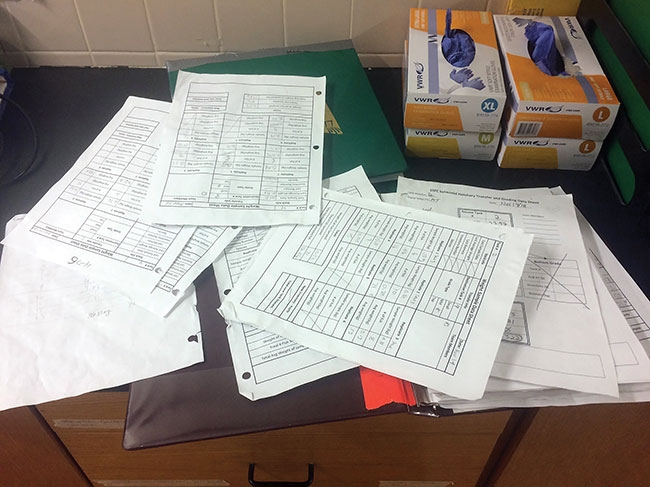
News & Views
Best practices to conquer data collection challenges
If you manage a site or facility, you have inevitably been frustrated and/or struggled with data collection.
April 5, 2019 By Ron Hill

Data that’s collected at aquaculture facilities is diverse – from feed and mortality numbers, to system statuses and water quality data. Despite the seemingly simple concept of collecting and recording data, it is often very poorly executed. Missing data, illegible numbers or handwriting, and tattered sheets are often the norm. Pick up a data binder by the spine and half the pages will spill out. When the data is entered into the inventory control program, frustration often ensues, trying to go back and decide what these numbers are, or should have been.
It’s easy to simply blame employees for bad collection and ineptitude, but often the real culprit is inconsistent or inadequate training, and poor data sheets. Look at the data sheets at your farm right now and see how many spots need to be updated.
Take control of the data
The key to getting control of your data collection is organization. To take back control of your data collection, consider these important steps:
- Data collected and recorded must be organized into forms and updated to include changes to the system.
- Consumables, kits and data collection points should be clearly labeled to match data sheets.
- Employees need to be properly trained to recognize, collect or produce data from the source, as well as properly fill out the datasheets.
Quality data sheets
The quality of your data sheet is reflected in the quality of your data. Here are some Dos and Don’ts when it comes to your data sheets.
Don’t
- overcomplicate or oversaturate the data sheets with marginally important data.
- collect data that has no purpose whatsoever.
- create confusion by failing to update data sheets, especially for new employees who often end up hunting for data points that don’t exist but are still on the data sheet.
Do
- ensure data sheets that are straightforward and updated regularly, and contain all relevant data used or tracked.
- have a clear label for each entry point on the sheet. Match the labels from the data collected to avoid confusion and prevent data from being entered in the wrong location.
- keep data sheets up-to-date by empowering an employee to oversee and update the paperwork, remove obsolete entries and go through all collected data to make sure the data sheets match the labeling.
Training
Data collection training is best done by having a new worker shadow a veteran employee for several days, so data collection points and methods can be reinforced through repetition. For complicated data sheets like transfers, grading sheets or feed data sheets where math must be done, have new or inexperienced employees fill out the data sheets and review them with the supervisor or shadowing employee. Notes and comments should be stressed to employees to give much needed context. Data collection training usually ends when the new employee can properly record the data on their own, but to get the most out of data collectors, advanced collection should be taught.
Advanced data collection is teaching employees how to look at and report on changes in your data, and should always be stressed to new and old employees. Too often, employees can get robotic about data collection and simply record the data without thinking: “This is the number I have come up with, it goes in the box, next number, next box.”
It must be stressed to workers that the numbers do mean something and noticing changes that occur in numbers and data day-to-day is of the utmost importance. A drop in the daily oxygen pressure indicates there is more oxygen demand or less supply – there is a reason for this. Less feed was eaten in several tanks today – there is a reason for this.
Changes in the data indicate things that need to be thought about and investigated, and employees need to know to bring up changes to supervisors even if they can’t interpret it. Turns out there was an oxygen hose dislodged causing a pressure drop. The dislodged hose caused the oxygen to decline in several tanks turning the fish off feed. It is best to teach workers advanced data collection as soon as possible, as the worker gains experience and understanding of the system, their independence will increase and their ability to solve problems on their own will make them much more valuable.
Sharing the analysis
As a manager or supervisor, one can reinforce the importance of data collection by showing or displaying the analysed data to the staff. The staff is often very interested in mortality rates and growth rate, or feeding improvement. Show the staff how the improvements or changes made have improved the farm. Show them how mortality rates are lower this season because of the new filtration system. A lot of time doesn’t need to be spent this way, but it’s important for employees to see how the data they collect are being used by the management and feel they are connected to it.
Print this page
Advertisement
- Bangladeshi shrimp industry to receive boost from European market
- Breeding to resist gill disease focus of new £3.5m project





